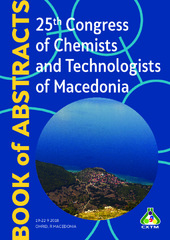| dc.creator | Pavun, Leposava | |
| dc.creator | Ćirić, Andrija | |
| dc.creator | Milenković, Marina | |
| dc.creator | Uskoković-Marković, Snežana | |
| dc.date.accessioned | 2023-11-09T17:06:27Z | |
| dc.date.available | 2023-11-09T17:06:27Z | |
| dc.date.issued | 2018 | |
| dc.identifier.uri | https://farfar.pharmacy.bg.ac.rs/handle/123456789/5220 | |
| dc.description.abstract | Flavonoids are a group of polyphenolic compounds widely present in the herbal world
representing an important part of human diet. Quercetin, which is a flavanol, makes 70% of total daily
intake of flavonoids. Because of the characteristic chemical structure, quercetin has the ability of
complexing metals and antioxidative ability.
Using equimolar solution variation method it was determined that quercetin makes a complex
with zinc(II)-ion in acidic environment (pH 5.25), in stoichiometric relation quercetin:zinc(II)-ion =
2:1, with absorption maximum on λmax=363 nm. The ability of quercetin to make complex
compounds with zinc(II)-ion was used to develop simple, precise and accurate assay to determine the
content of quercetin in various samples of heterogeneous composition.
The proposed indirect spectrophotometric method can selectively determine quercetin in
concentrations ranging from 0.1 to 6.0 mg/L. LOD and LOQ were derived from the calibration curve
and estimated as 0.03 mg/L and 0.1 mg/L respectively. Developed method is reproductive and
accurate, as indicated by high value of correlation coefficient R=0.99996 and low value of
SD=0.00122. Method was successfully used to determine quercetin content in dietary supplement
tablets. Dietary supplements, proscribed for therapeutic and/or profilactic pruposes, usualy content
quercetin combined with other flavonoids and ascorbic acid. Therefore, it was necessary to test the
selectivity of proposed method.
The reliability of the method was checked out by newly developed RP-HPLC/UV method for
capsules with direct determination of quercetin after separation. The good agreement between the two
methods indicates the applicability of the proposed spectrophotometric method for quercetin
determination in dietary supplement tablets with high reproducibility, and enables direct and simple
determination without its prior extraction from samples.
In addition, the antioxidative ability of quecetin and zinc(II)-quercetin complex was
determined using oxidation-reduction standardized methods DPPH and FRAP. The same samples
were tested for antimicrobial activity against seven laboratory control strains of bacteria and one
yeast. As a result of those tests, there are no obstacles to combine quercetin and zinc in the same
formulation. | sr |
| dc.language.iso | en | sr |
| dc.publisher | Society of Chemists and Technologists of Macedonia | sr |
| dc.relation | info:eu-repo/grantAgreement/MESTD/Basic Research (BR or ON)/172043/RS// | sr |
| dc.relation | info:eu-repo/grantAgreement/MESTD/Basic Research (BR or ON)/172016/RS// | sr |
| dc.rights | openAccess | sr |
| dc.source | 25th Congress of Chemists and Technologists of Macedonia, 19–22 September 2018, Ohrid, R. Macedonia | sr |
| dc.subject | quercetin | sr |
| dc.subject | complex | sr |
| dc.subject | zinc(II)-ion | sr |
| dc.subject | antioxidative ability | sr |
| dc.subject | spectrophotometry | sr |
| dc.title | Spectrophotometric zinc(II) based determination of quercetin in pharmaceutical formulations | sr |
| dc.type | conferenceObject | sr |
| dc.rights.license | ARR | sr |
| dc.citation.spage | 119 | |
| dc.citation.epage | 119 | |
| dc.identifier.fulltext | http://farfar.pharmacy.bg.ac.rs/bitstream/id/14489/Spectrophotometric_Zinc_II_pub_2018.pdf | |
| dc.identifier.rcub | https://hdl.handle.net/21.15107/rcub_farfar_5220 | |
| dc.type.version | publishedVersion | sr |

